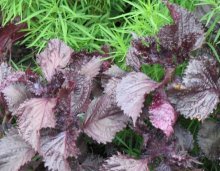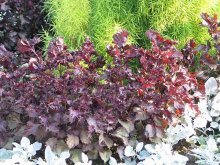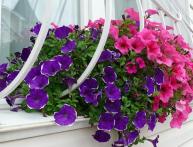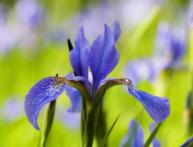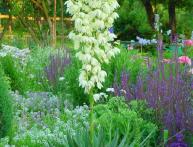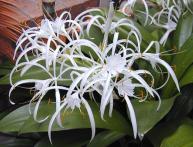Perilla bush, description, varieties, cultivation and care
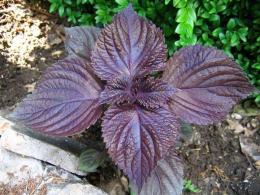
Perilla is a plant that many have paid attention to, as it is increasingly used in landscaping populated areas. Particularly eye-catching are varieties with purple and variegated leaves, which are most often planted along paths, along the edges flower beds. One gets the impression that the plant is grown exclusively for its leaves, which are dark red or variegated. However, not many people know that bush perilla is also an edible and medicinal plant.
Content:
- Perilla, description of the plant
- Perilla shrub varieties for growing in temperate climates
- How to plant perilla seedlings
- Planting perilla seedlings in the ground and caring for them
Perilla, plant description
Perilla is a genus of annual herbaceous plants from the subfamily Catnipaceae, family Lamiaceae (Lamiaceae). To some extent, it is related to lavender, mint, and basil. The genus Perilla includes six species. The most famous is perilla bush or basil. It reaches a height of 0.8 - 1.4 meters, the leaves are oval, petiolate or sessile. The arrangement of the leaves is opposite. There are railings with leaf plates:
- Red
- Green colour
- variegated color
Flowers in the form bells, small, often whitish or cream in green forms, with a slight purple tint in red leaf forms. Flowers are located on short, pubescent pedicels.They are collected at the ends of peduncles into an inflorescence panicle or raceme. In place of the flower, a dry fruit is formed, which is subsequently divided into four nuts. These nuts contain small seeds. They contain up to 45% essential oil. It is highly valued in the production of quickly drying varnishes and paints.
After special purification, perilla seed oil is considered very beneficial. In addition, the purified oil and leaves of the plant are used as food for preparing salads and other dishes. In Asian countries, it is not only a popular salad and spicy crop, but also a useful medicinal plant. The benefits of perilla are due to its high carotene content; it contains more of it than carrots. Also present in the plant:
- essential oils
- iron
- potassium
- calcium
- magnesium
- vitamins C, RR, B 1, B2
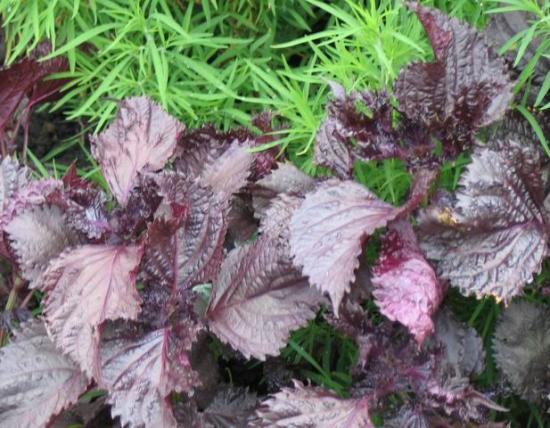
Due to the content of the perillamine pigment, the plant is used as an analgesic and anti-inflammatory agent. It is used to strengthen the immune system, heart and blood vessels, and improve vision. Perilla is considered an effective contraceptive in folk medicine.
In addition, perilla is planted as an ornamental plant in landscape design. Thus, by growing perilla on your site, you can combine the plant’s decorative properties with its medicinal and culinary properties.
Perilla shrub varieties for growing in temperate climates
The most famous Japanese varieties of perilla are called:
- Aoshisa, green leaves
- Akoshisa, red leaves
Japanese varieties They are distinguished by good growth of leaf mass and unpretentiousness.
The following varieties of domestic selection are grown as an agricultural crop.
- Dewdrop, productive, early ripening, with good cold resistance, green leaves
- In memory of Covas, early
The plant is cut for food throughout the season. During mass harvesting, cutting begins at the beginning of flowering. It is produced at a height of 10 cm from the ground. Cut perilla remains fresh for about a week. To harvest for future use, perilla is dried, crushed and stored in hermetically sealed jars. For decorative purposes, you can plant a variety of shrub perilla such as Mulatto. The height of the plant of this variety reaches 0.8 m. The crown is pyramidal, the leaves are beautifully cut along the edge, slightly corrugated, violet-red. To prevent the plant from losing its decorative appearance, the flower stalks are removed from it.
In the garden landscape, perilla is most often used as a border plant. In mixed flower plantings, perilla with dark-colored foliage perfectly shades any flowering plants and combines with plants with light, bluish or silver foliage. When growing perilla shrub for decorative purposes, part of it can be stored for future use in cooking and as a means of traditional medicine.
How to plant perilla seedlings
In temperate climates, bush perilla is grown through seedlings. This is due to the fact that its seeds not only take a long time to germinate, but also grow very slowly at first. The time for planting perilla seedlings is the end of March - April. In order to speed up the germination of seeds, they are soaked in water for 72 hours. At this time, repeated changes of water are required. It is best to do this every three to four hours.
Perilla is undemanding to the soil. Mix two parts of humus soil with one part of peat and spill with a solution of mineral fertilizers. Pots for seedlings are filled with drainage material; ordinary expanded clay is suitable. After this, they are filled with soil and seeds are sown.This can be done in shallow, moistened grooves without embedding in the ground.
Cover the box with film and place in a warm place. When the roots emerge, lightly dust the grooves with fine sand and moisten them. This procedure can be repeated again. Green sprouts appear around the tenth day.
When the plant has two or three leaves, the seedlings can be planted in separate cups. You should not replant perilla into a common container, as planting in the ground can damage the roots. Bush perilla is planted in the ground in the first ten days of June. Important! If you need to get mature seeds from perilla during the growing season, then seedlings need to be sown much earlier, no later than the first days of February, otherwise in a temperate climate they will not have time to ripen. If you need a few seeds, only as seeding material for personal needs, then in mid-autumn, one or two perilla bushes are transplanted into pots and then the seeds have time to ripen at home. They are quite enough for growing new seedlings.
Planting perilla seedlings in the ground and caring for them
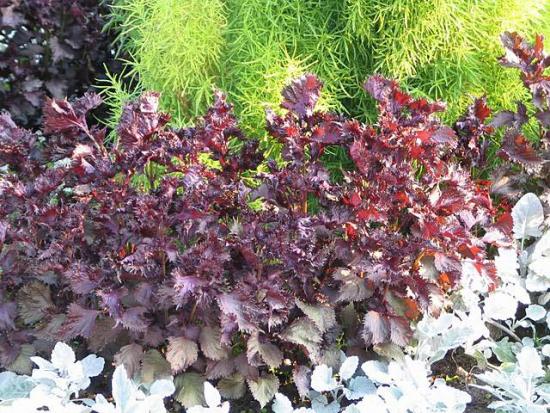
Selecting a location
If perilla is grown as a vegetable crop, a well-lit area protected from the wind is suitable for it. The soil must be loose and permeable. The best predecessors are peas and beans. In the south, perilla can be sown before winter, and in temperate climates it can be grown through seedlings. If possible, it is advisable to add rotted compote in the fall. Dig up the soil using the bayonet of a shovel. Application rate - 3 kg per sq.m. In spring, you can apply complex mineral fertilizer immediately before planting.
Planting seedlings in the ground
As soon as the average daily temperatures reach +10 +12 degrees, the perilla is transplanted into open ground.Planting density is 25 perilla bushes per square meter. The distance between rows is 40 cm, between plants - 30 cm. Basic care is as follows:
- watering
- feeding
- loosening
- weeding
- pinching
For feeding, use a small amount of dry chicken manure, scattering it under the bushes. Perilla tolerates minor drought well, but if the summer is dry, then it needs watering. Today, perilla shrub is gaining more and more attention from gardeners and cooks; perhaps it is worthy of growing on your site.
Video about the perilla plant:
Interesting information about the vegetable garden

